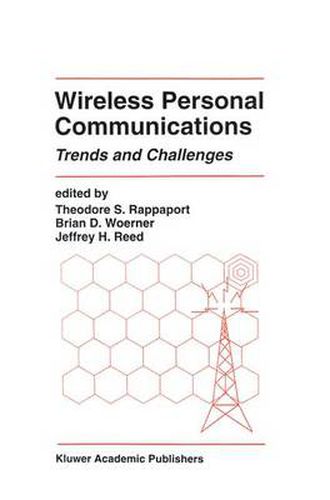Readings Newsletter
Become a Readings Member to make your shopping experience even easier.
Sign in or sign up for free!
You’re not far away from qualifying for FREE standard shipping within Australia
You’ve qualified for FREE standard shipping within Australia
The cart is loading…






This title is printed to order. This book may have been self-published. If so, we cannot guarantee the quality of the content. In the main most books will have gone through the editing process however some may not. We therefore suggest that you be aware of this before ordering this book. If in doubt check either the author or publisher’s details as we are unable to accept any returns unless they are faulty. Please contact us if you have any questions.
Wireless Personal Communications: Trends and Challenges presents a wide range of current research activities in wireless communications, reflecting the rapid growth and maturity of the wireless industry. Although overcoming the propagation characteristics of the wireless channel will remain the unique problem confronted by wireless system designers, a plethora of innovative techniques for equalization and interference rejection have emerged. New applications of wireless systems have also been proposed and implemented, ranging from high data rate paging to video transmission. Research in code division multiple access (CDMA) has begun to move from performance evaluation to system design. Research also continues on a broad range of simulation, coding and multiple access techniques. As the wireless community has expanded, there has been a need to draw upon expertise in seemingly disjoint disciplines such as semiconductor design and fabrication, and human factors. In this book, the large number of chapters with multiple authors and from multiple institutions is indicative of the collaborative nature of wireless research, necessitated by the increasing complexity and breadth of wireless systems. This text is organized into five sections, each focusing on a distinct set of issues in wireless communications. It should be a useful reference and may be used as a text for advanced courses on wireless communications.
$9.00 standard shipping within Australia
FREE standard shipping within Australia for orders over $100.00
Express & International shipping calculated at checkout
This title is printed to order. This book may have been self-published. If so, we cannot guarantee the quality of the content. In the main most books will have gone through the editing process however some may not. We therefore suggest that you be aware of this before ordering this book. If in doubt check either the author or publisher’s details as we are unable to accept any returns unless they are faulty. Please contact us if you have any questions.
Wireless Personal Communications: Trends and Challenges presents a wide range of current research activities in wireless communications, reflecting the rapid growth and maturity of the wireless industry. Although overcoming the propagation characteristics of the wireless channel will remain the unique problem confronted by wireless system designers, a plethora of innovative techniques for equalization and interference rejection have emerged. New applications of wireless systems have also been proposed and implemented, ranging from high data rate paging to video transmission. Research in code division multiple access (CDMA) has begun to move from performance evaluation to system design. Research also continues on a broad range of simulation, coding and multiple access techniques. As the wireless community has expanded, there has been a need to draw upon expertise in seemingly disjoint disciplines such as semiconductor design and fabrication, and human factors. In this book, the large number of chapters with multiple authors and from multiple institutions is indicative of the collaborative nature of wireless research, necessitated by the increasing complexity and breadth of wireless systems. This text is organized into five sections, each focusing on a distinct set of issues in wireless communications. It should be a useful reference and may be used as a text for advanced courses on wireless communications.